Skip to comments.
Attack On Europe: Documenting Russian Equipment Losses During The 2022 Russian Invasion Of Ukraine (2 year anniversary)
ORYX ^
| Since February 24, 2022 and daily
| ORYX
Posted on 02/24/2024 5:59:01 AM PST by SpeedyInTexas
This list only includes destroyed vehicles and equipment of which photo or videographic evidence is available. Therefore, the amount of equipment destroyed is significantly higher than recorded here. Loitering munitions, drones used as unmanned bait, civilian vehicles and derelict equipment are not included in this list. All possible effort has gone into avoiding duplicate entries and discerning the status of equipment between captured or abandoned. Many of the entries listed as 'abandoned' will likely end up captured or destroyed. Similarly, some of the captured equipment might be destroyed if it can't be recovered. When a vehicle is captured and then lost in service with its new owners, it is only added as a loss of the original operator to avoid double listings. When the origin of a piece of equipment can't be established, it's not included in the list. The Soviet flag is used when the equipment in question was produced prior to 1991. This list is constantly updated as additional footage becomes available.
(Excerpt) Read more at oryxspioenkop.com ...
TOPICS: Military/Veterans
KEYWORDS: 0killthisthread; 0putinsfolly; 0putinswar; 1637borders; 3daywar; agitprop; alfredeblitz; americalast; angrykeywordtroll; anotherputinfail; anydaynow; anydaynowputinwins; anydaynowrussiawins; anydaynowukrainewins; assistantdemsonfr; attackoneurope; beaubothebsartist; beauzo; bidenswar; bobomaximus; breevingroom; byepif; byespeedy; cantbreev; cheesymaximus; crazyivan; dailydeathfap; dailypropaganda; deadthread; deathcult; deepinthespamforest; delusionalzeepers; demyanganul; dimwit; dippythemelon; dualcitizenssuck; escalation; fishiemaximus; foreigntrolls; foreigntrollsonfr; formersovietofficers; freeploader; freeploadingspammer; gabbagabbahey; ghoulishdelight; gleefulnosegold; globohomo; goodriddance; hopium; irynazarutska; itsoveriwasright; jonboy; jonboyputinlover; jonputinbot; keiththedimwit; kievstronk; liberalatpost7819; liedaboutleaving; melon; melonballsforever; melonlovesputin; melonlovesrussia; melonmemewarrior; melonmlrs; motherpif; muscovite; nato; omgputinputinputin; oyveygoyim; paidazovfans; paidazovtrolls; paidrussiantrolls; pancakemaximus; phdft; pifpouf; pifpuffs; planetzeep; polygamy; propagandareturns; put; putin; putinsfolly; putinstarted; putinswar; russia; russiandelusions; saintvolodymyr; siloviki; slaviccivilwar; slavictrolls; snufffilmsonfr; snufffilmtx; snuffpornforzeepers; snuffyfromtexas; spammyintexas; speedomaximus; speedycameback; speedyhadenough; speedyintroll; speedyisaliveandwell; speedyisdeadandfried; speedylied; stankazzintx; stankazztexicunt; staygonethistime; stenrynning; stinkstankstunkazz; stpetersburgtrolls; talkingtomypif; thisthreadisdead; tippecanoeandpiftoo; toldyouso; tothelastrussian; tothelastukrainian; ukraine; unhealthyobsession; usaidcheckbounced; usaidtrolls; vladtheimploder; warporn; wellbye; wildberry; yostanky; yurpstronk; zeepercirclejonk; zeepercreepers; zeeperdeathcult; zeeperhomeworld; zeeperloveazov; zeeperpr0n; zeepers; zeepersjustwannazeep; zeeperslovedeath; zeeperslovevindman; zeepersworshipdeath; zeepervictoryparade; zeepharder; zeeploaders; zeepyintexas; zipadeedoodah; zot; zottedintexas; zottyintexas
Navigation: use the links below to view more comments.
first previous 1-20 ... 11,001-11,020, 11,021-11,040, 11,041-11,060 ... 22,221-22,233 next last
To: PIF; SpeedyInTexas; BeauBo
From Russia, 16 people were sent to fight in the Kursk region straight from the sobering-up center. 🥃😵
62-year-old Evstefeev Nikolay Nikolaevich was detained while driving while intoxicated and was sent to the 22nd motorized rifle regiment (military unit 72164).
According to him, a contract with the Russian Armed Forces was slipped to him instead of a protocol.
As a result, the command sent them to storm the forest plantations without food.
Grandpa was lucky - he was captured, but the others were less lucky - "the dead are lying around, no one is taking them."
https://x.com/albafella1/status/1882855602986053872
![]()
To: PIF; FtrPilot; SpeedyInTexas; BeauBo
11,022
posted on
01/25/2025 10:08:53 AM PST
by
AdmSmith
(GCTGATATGTCTATGATTACTCAT)
To: AdmSmith
Reporting From Ukraine:
https://www.youtube.com/@RFU/videos
Reporting From Ukraine Uncensored Combat Footage (from this and past Reports) is found on Telegram:
https://t.me/RFUEnglish or @RFUEnglish
[ You need to have the Telegram app to view the larger videos. ]
The complete transcript.
—
[ Ukrainians Obliterate a Massive Russian Tank Assault! ]
Today [ Jan 24, 8 pm ], the biggest updates come from the Kursk direction.
Here, Russian forces unleashed a relentless wave of mechanized assaults, aiming to finally achieve a decisive breakthrough in the Ukrainian western flank.
However, Ukrainians turned the pre-existing Russian defenses in Kursk against them, unleashing a barrage of drones and ATGM’s, as the Russian columns tried desperately to move forward.
The goal of the Russian forces in this area is to take control of Malaya Loknya. This would allow the Russians to successfully isolate the Ukrainian forces in the northern part of Kursk salient, and cut off Ukrainian ground lines of communication with their main logistics hub in Sudzha.
To accomplish this, Russian commanders employed large assault formations, deploying 4 waves of platoon-sized mechanized units, each with 3 to 4 armored vehicles, supported by tanks. These units aimed to cross from their positions in Novoivanovka as quickly as possible to secure Viktorovka and reach the doorstep of Malaya Loknya.
The main advantage of Russian forces lay in the speed and firepower of their mechanized assault units, compared to human waves of infantry, minimizing the exposure to Ukrainian precision fire. However, these advantages were heavily undermined by the terrain configuration, the weather, and even their own equipment.
Learning from previously failed mechanized assaults, due to Ukrainian landmines, Russians used mine crawlers on the lead tanks. This forced them to advance over the fields and at an incredibly slow pace, in order for the de-mining equipment to do its work properly, making them easy targets for Ukrainian strike and reconnaissance drones.
To make matters worse, old Russian dragon teeth fortifications, from before the Ukrainian Kursk incursion remain, heavily restricted Russian movement during their assault.
Additionally, slightly warmer temperatures have melted the snow and soaked the fields, further slowing down Russian armored columns, while craters from prior Russian airstrikes have completely flooded, forcing Russian units into predictable chokepoints. The combination of mud, dragon teeth, and exposed terrain, enabled Ukrainian forces to effectively target and destroy these Russian assaults through all available means.
Combat footage from the area reveals how the Ukrainian defenders effectively engaged a Russian assault platoon consisting of 3 infantry fighting vehicles and 1 tank. The column moved across the field from Novoivanovka to Viktorovka, maneuvering around the dragon’s teeth and flooded bomb craters.
The hindered movement of the 1st Russian assault allowed Ukrainians to completely dismantle on the approaches with FPV kamikaze drone strikes and artillery.
However, some vehicles from the 2nd wave of mechanized assaults managed to approach and enter the village of Viktorovka, but quickly found themselves targeted by Ukrainian anti-tank teams, sporting Javelin anti-tank guided missile launchers.
As their armor stood no chance against the modern weapon systems, Russian soldiers were forced to scatter across the fields and village in disorganization, where they were systematically hunted down by Ukrainian drone operators dropping grenades from above.
In a final effort to gain a bridgehead in Viktorovka, the Russians deployed 2 additional mechanized platoons in 2 separate assaults, following the exact same route of attack as previous columns, that had cleared a path through the minefields.
However, this made both these Russian assaults extremely predictable, as Ukrainian drone operators observed and dismantled the mechanized platoons, which consisted of BMDs with paper-thin armor that could be destroyed with a single FPV drone strike.
After the final mechanized threat was dealt with, Ukrainians turned their attention to the Russian survivors, eliminating dozens of them with drone-dropped grenades and small arms fire.
Overall, the Russian assaults south of Malaya Loknya were completely undermined by the terrain configuration, pre-existing field fortifications, and the slower speed of their own equipment. Ukrainians masterfully amplified these weaknesses through extensive drone fire control and dedicated anti-tank missile teams, positioned safely behind the frontline. The failure of each mechanized assault only led to Russian commanders sending another, hoping to finally achieve a meaningful breakthrough.
This Russian form of dedication reflects a recently published statistic from the Ukrainian Ministry of Defense, stating that around 40% of all combat engagements take place in the Kursk region, underlining Ukraine’s massive success at preventing operationally significant Russian gains, while diverting a large number of resources away from ongoing offensive operations in the east.
11,023
posted on
01/25/2025 10:30:58 AM PST
by
PIF
(They came for me and mine ... now its your turn)
To: SpeedyInTexas
Russia sinks or swims on the price of oil - its center of gravity.
Kyiv Independent reports:
“Stricter measures targeting Russia’s oil industry could pressure the Kremlin to negotiate an end to the war in Ukraine, Keith Kellogg, incoming peace envoy for U.S. President Donald Trump, told FOX News on Jan. 24…
…Kellogg argued that reducing Russia’s oil revenues (by reducing the price they get) to $45 per barrel, its breakeven point, could weaken Moscow’s financial resilience and force it to seek a settlement.”
To: SpeedyInTexas
Reporting From Ukraine:
https://www.youtube.com/@RFU/videos
Reporting From Ukraine Uncensored Combat Footage (from this and past Reports) is found on Telegram:
https://t.me/RFUEnglish or @RFUEnglish
[ You need to have the Telegram app to view the larger videos. ]
The complete transcript.
—
[ Chaos in Kursk: North Koreans Revolt. Alliance Shattered ]
Today [ Jan 25, 8 pm ], there are a lot of interesting updates from the Kursk direction.
Here, the fragile alliance between Russian and North Korean forces begins to unravel as mounting losses and reckless tactics fuel bitter resentment.
In a shocking turn, rogue North Korean soldiers took matters into their own hands, deliberately targeting their supposed allies, exposing the deep fractures within the combined Russian and North Korean operation in Kursk.
The goal of the Russian forces in this area is to ensure that the offensive does not lose momentum and does not culminate. This is because their forces have finally approached Malaya Loknya close enough to initiate a new phase in their counteroffensive, forcing North Korean forces to adapt to completely new combat conditions.
The agglomeration of settlements in this area, including Malaya Loknya, provides much better defensive positions for the Ukrainian forces, which the North Koreans will have to meet in direct close quarters combat, which would undoubtedly result in very high losses.
So far, North Koreans suffered around 4,000 casualties in one and a half months of fighting, and at this rate, it is expected that they will run out of soldiers by April.
The Russian commanders understood this and attempted to complement the North Korean infantry-based meat waves with Russian infantry, tanks, armored personnel carriers, artillery, and close air support.
In the long term, a source with the United States Department of Defense shared that a new agreement between Russia and North Korea was set to deploy an additional 11,000 North Korean soldiers to Kursk within the next 2 months to replace current losses.
Combat footage reveals the continued suicidal tactics used by the North Koreans, which is slowly leading to the complete annihilation of their contingent. The lack of leaves on the trees during winter and the large movements of North Korean soldiers made them easy targets for Ukrainian drones to correct precision artillery fire with cluster munitions, leading to massive losses.
Further assaults over open fields directly exposed them to Ukrainian machine gun fire from fortified and concealed positions within the forests.
Furthermore, the fact that Ukrainians sport far superior equipment, such as night vision goggles and thermal vision sights, gave them an upper hand in every direct engagement, resulting in North Koreans coming under precise small-arms fire, without being able to properly fight back. All of this contributed to North Korean forces losing over a 3rd of their initial force in just 7 weeks of fighting.
Such tremendous losses and lack of adequate fire support from the Russians created an outrage among surviving North Korean soldiers, who were traumatized from battles where they often had to walk over the corpses of their comrades. Their anger was further fueled by the footage, which revealed that Russians collected and tried to hide the bodies of dead North Korean soldiers to downplay their losses.
As a result of this, a group of 3 North Korean soldiers expressed their outrage about the disrespect they faced by deliberately attacking a group of Russian marines, killing 5 of them in the following altercation. Russian news sources published an image of the wanted list issued for the 3 North Korean soldiers who conducted the ambush, reporting that they are currently still at large, with the search for the perpetrators ongoing.
Overall, the poor treatment and even worse tactics of North Korean soldiers by the Russian command in Kursk, fueled heavy resentment amongst the North Korean soldiers, causing some of them to go rogue and kill several Russian soldiers. Continuation of poor treatment and the disregard for the life of North Korean soldiers will, at this rate, both lead to the complete annihilation of the North Korean expeditionary force of 12,000 soldiers, along with further deteriorating relations between the fighting two parties.
Russian soldiers will also likely become increasingly unwilling to support their North Korean allies, due to the sheer number of cases where North Koreans fire on Russian soldiers, both deliberately and by accident.
However, instead of solving the issue at hand, Russian forces plan to deploy an additional batch of 11,000 North Korean soldiers to Kursk to compensate for the loss of the current contingent within the coming months.
11,025
posted on
01/25/2025 1:41:28 PM PST
by
PIF
(They came for me and mine ... now its your turn)
To: AdmSmith; ETCM
It’s over for Tartus.
MSN reports:
“The Syrian government has canceled the lease agreement that allowed Russia access to the port of Tartus. According to British intelligence and other sources, this presents a significant problem for the Kremlin, as it has lost one of its most crucial bases outside Russia…
…Russia ousted from Syrian base
The Syrian government canceled the 2019 lease agreement, which was set for a 49-year term. However, permission was granted for several Russian cargo ships, which had been waiting at sea for some time, to enter the port.”
(Reportedly, the EU had made removing Russian bases a condition for lifting sanctions on Syria).
Russian Offensive Campaign Assessment, January 25, 2025
The Kremlin is continuing to leverage the prominent Kremlin-linked Rybar Telegram channel to cultivate increased Russian influence in Iraq. The Rybar channel claimed on January 25 that members of the Rybar team – including its founder Mikhail Zvinchuk – visited Iraq over the last week and met with Iraqi officials, including Iraqi Prime Minister Mohammad Shia Al Sudani.[4] The channel claimed that Iraqi officials noted their openness to increasing trade and foreign investments with Russian partners and their interest in further developing Russian–Iraqi relations. The channel welcomed Russian businesses, media companies, bloggers, and investors to begin exploring opportunities in Iraq. Member of the Rybar team visited Iraq in August 2024, and ISW noted at the time that this was the first observed report of a Russian milblogger meeting with a senior foreign official.[5] ISW-CTP previously assessed that Russia may be setting conditions to supplant the US as a security partner in Iraq in anticipation of the US possibly reducing its military presence there.[6] The recent fall of the Bashar Al-Assad regime in Syria may be prompting the Kremlin to reconsider the contours of its relations with Iraq.
https://www.understandingwar.org/backgrounder/russian-offensive-campaign-assessment-january-25-2025
11,027
posted on
01/26/2025 12:29:06 AM PST
by
AdmSmith
(GCTGATATGTCTATGATTACTCAT)
To: BeauBo
11,028
posted on
01/26/2025 12:44:33 AM PST
by
AdmSmith
(GCTGATATGTCTATGATTACTCAT)
1,720 i.e. more than 1.19 Russians and Norks/min. Vehicles and fuel tanks 50% above the average.
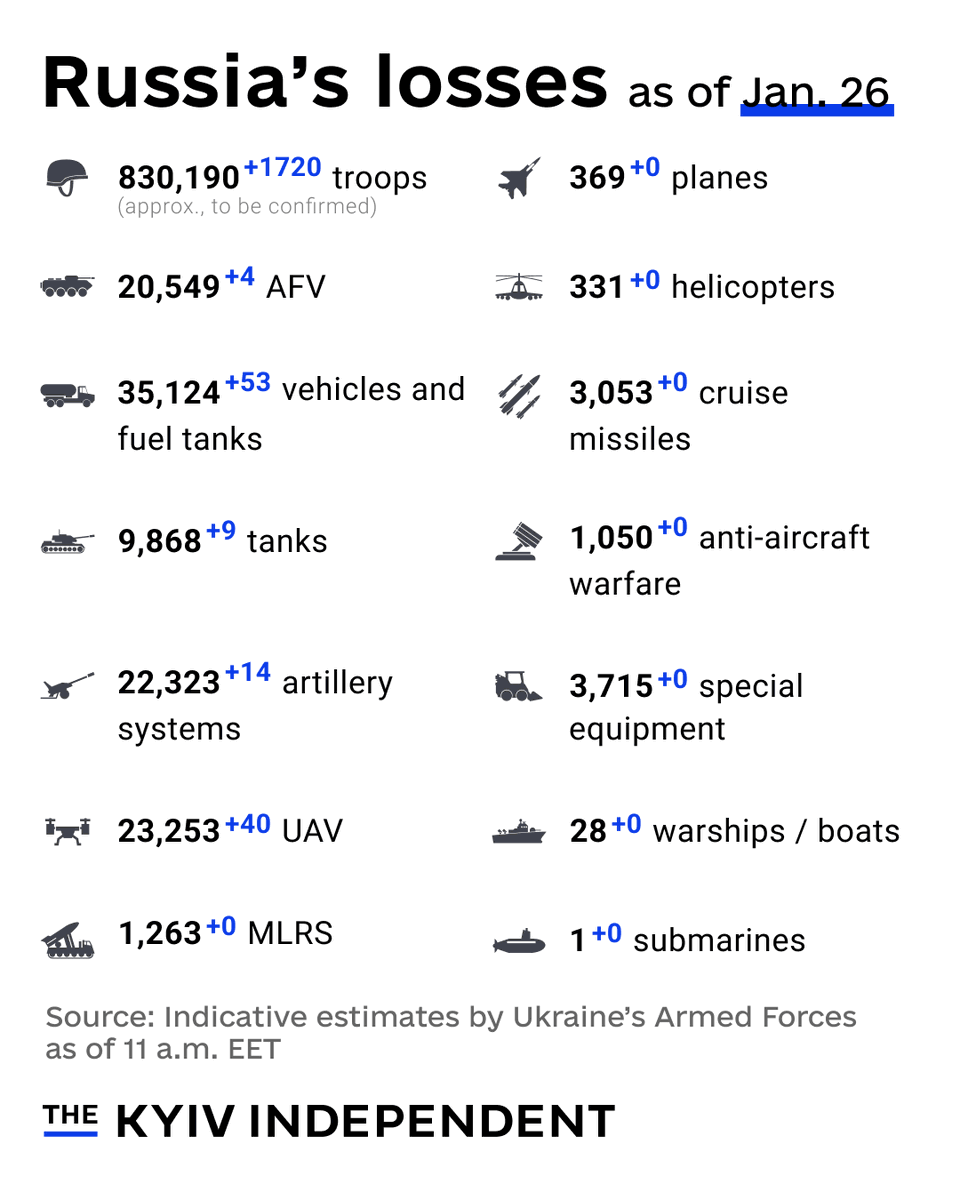
11,029
posted on
01/26/2025 12:48:12 AM PST
by
AdmSmith
(GCTGATATGTCTATGATTACTCAT)
To: FtrPilot; marcusmaximus
Ryazan Refinery struck again.
Kyiv Independent reports:
“A fire erupted at Russia’s Ryazan Oil Refinery after a drone strike overnight on Jan. 26, according to Russian media reports.
The reported strike comes two nights after the Security Service of Ukraine (SBU) and Ukraine’s Special Operations Forces (SOS) launched a joint attack against the Ryazan Oil Refinery on Jan. 24.
Locals reported sounds of explosions and an attempted drone attack on the refinery shortly before 1 a.m. on Jan. 26, the Russian Telegram news channel Astra said. Ryazan Oblast Governor Pavlo Malkov confirmed that Russian air defense units were repelling a drone attack in the region...
…The Ryazan Oil Refinery, one of Russia’s largest, has the capacity to process 17 million metric tons of oil per year…
…Ukrainian forces have targeted the Ryazan facility in previous attacks. An SBU source told the Kyiv Independent that at least three oil depots and a workshop were set ablaze in the Jan. 24 strike.
Ukraine’s military intelligence agency (HUR) also carried out a drone attack on the Ryazan Oil Refinery on May 1, 2024.”
To: gleeaikin; PIF; blitz128; FtrPilot; BeauBo; USA-FRANCE; canuck_conservative; marcusmaximus; ETCM
Кремлевская табакерка 26JAN2024
Putin was offered to remove Lenin from the Mausoleum and “make room there for the real Emperor”
Philosopher Alexander Dugin approached the president with this proposal. “I once wrote that faith in Putin is like faith in the Emperor. I believe that our Emperor lacks a number of attributes that would finally make his role in the history of Russia sacred. And the future place of his burial, a place of worship for all the successes of modern Great Russia - that is what is sorely lacking now,” Alexander Gelyevich told our channel.
He reported that he conveyed to Vladimir Vladimirovich the proposal: to remove Lenin's body from the Mausoleum, “make room there for the real Emperor”, to slightly rebuild this structure, decorate it with military trophies accumulated during the SVO. And to prepare the Mausoleum for the current president to be buried there, “hopefully not soon, but definitely there.”
“Putin's Mausoleum can already be worshiped. And when Vladimir Vladimirovich finishes his earthly journey, there will be queues at his coffin. We will bring here the flags of the European states that we will conquer in the coming years and decades. And Western tanks taken from our enemies,” Dugin added.
The Kremlin confirmed to us that they had indeed received the philosopher's proposal. And it caused a dual reaction. On the one hand, sources in the Presidential Administration smiled in response to the proposal to prepare a Mausoleum for Vladimir Vladimirovich. And they did not comment on this topic, noting that the president “will outlive many more.” On the other hand, they reminded us that Putin has long been thinking about removing Lenin's body from the Mausoleum. Now this process can be accelerated.
https://t.me/kremlin_secrets/5214
They are discussing the death of Putin, and Lenin will be shipped to North Korea or China?
11,031
posted on
01/26/2025 1:00:20 AM PST
by
AdmSmith
(GCTGATATGTCTATGATTACTCAT)
To: AdmSmith
“our Emperor… make his role in the history of Russia sacred. And the future place of his burial, a place of worship”
Wow, and I thought that I had seen shameless butt kissers before. This guy takes the cake.
To: JonPreston; PIF; USA-FRANCE
PIF #10,989:
"All of us try to avoid commenting to 🍈 as he just brings more of his 🦠 friends.
At present, his aim seems to be to discourage anyone reading this thread by posting inane graphics and 🦑-like comments" I agree with shunning bad behavior.
JonPreston: "Thoughts on your government trying to kill its own citizens?"
"A declassified CIA document reveals that in the 1960s, the US military planned Operation Northwoods (1962), which involved committing acts of terrorism against American citizens to justify a war with Cuba."

In
1962 I was a boy, a student at Monterey High School (California), and sometimes discussed international relations with a kid my age who debated like JonPreston -- forever bringing up "facts" to prove that the US was always wrong, and the Russians or Chi-Coms were always right.
Of course, none of his "facts" were part of the public discussions as I knew them, nor could I prove him right or wrong at that time.
In the case of 1962's Operation Northwood, we now know the key fact, and that is: Northwood was rejected by Pres. Kennedy.
For comparison, consider:
- Operation TPAJAX (1953) was approved by then Pres. Eisenhower, to overthrow the communist government in Iran, and TPAJAX included staging attacks on mosques, to blame on communists.
- TPAJAX did not involve the deaths of any Americans.
- That 1953 coup was overturned in 1979, by Pres. Carter when he allowed the Shah of Iran to fall and the Mullahs to take control of Iran.
- We can well ask, which event benefitted Iranians and the world more?

Finally, it would be an interesting question to discuss, whether the CIA learned its coup tradecraft from the KGB, or was it the other way around?
The list of Soviet/Russian KGB/FSB sponsored coups, rebellions & oppressions is rather long & bloody, including***:
- 1948 Support for the Greek Communists' civil war.
- 1949 Support for Philippines Hukbalahap rebellion
- 1950 Support for Korean invasion
- 1953 Suppression of East Germans' uprising
- 1956 Suppression of Hungarian Revolution
- 1959-1975 Support for North Vietnam's war
- 1961-1965 Support for Congo rebellion
- 1965-1979 Support for Rhodesia's ZAPU forces
- 1967-1970 Suppression of Nigerian Biafran rebels
- 1968 Suppression of Czechoslovakian Revolution
- 1979 Sponsored Afghanistan coup
- 1983 Suppression of Poland's Solidarity uprising
- 1991-1992 Georgian coup
- 1992-today Invasion of Moldova-Transnistria
- 1993 Azerbaijan coup
- 1994-2009 Chechen Wars
- 2008-today Invasions of Georgia
- 2014-today Invasions of Ukraine
- 2016 Montenegrin coup plot
- 2020 Malian coup d'état
- 2023 Moldovan coup d'état attempt
- 2023 Sudan conflict Wagner Group support
*** a partial listing.
Suspected FSB false flag operations against its own citizens & supporters include:
- 1999 Apartment bombings in Moscow, Buynaksk, and Volgodonsk, killing over 300 people and injuring more than 1,000.
Officially blamed on Chechens -- and used to justify the Second Chechen War -- evidence points at the FSB. - 2002 Nord-Ost Theater Siege -- again blamed on Chechens and again used to justify further military operations in Chechnya.
- 2004 Beslan School Siege -- same old, same old...
- 2014 Odessa, Ukraine, May 2 attack by Donbas Russian separatists, orchestrated by FSG & other Russian forces, against Ukrainian loyalists resulting in dozens of separatists' deaths in the Trade Union House fire.
11,033
posted on
01/26/2025 2:21:16 AM PST
by
BroJoeK
(future DDG 134 -- we remember)
To: BeauBo
Christian nation? One that worships putin, got it 😎
To: PIF
Would not be surprised if that number is closer to 2-1 wounded to dead
To: blitz128
Would not be surprised if that number is closer to 2-1 wounded to dead
—
Agreed. I was just being conservative, since it is impossible, at this point, to say otherwise.
11,036
posted on
01/26/2025 4:32:25 AM PST
by
PIF
(They came for me and mine ... now its your turn)
To: BeauBo
11,037
posted on
01/26/2025 4:34:27 AM PST
by
PIF
(They came for me and mine ... now its your turn)
To: BroJoeK
 Politics portal
Politics portal In foreign policy, the neoconservatives' main concern is to prevent the development of a new rival. Defense Planning Guidance, a document prepared during 1992 by Under Secretary for Defense for Policy Paul Wolfowitz, is regarded by Distinguished Professor of the Humanities John McGowan at the University of North Carolina as the "quintessential statement of neoconservative thought". The report says:[89]
Our first objective is to prevent the re-emergence of a new rival, either on the territory of the former Soviet Union or elsewhere, that poses a threat on the order of that posed formerly by the Soviet Union. This is a dominant consideration underlying the new regional defense strategy and requires that we endeavor to prevent any hostile power from dominating a region whose resources would, under consolidated control, be sufficient to generate global power.
According to Lead Editor of e-International Relations Stephen McGlinchey: "Neo-conservatism is something of a chimera in modern politics. For its opponents it is a distinct political ideology that emphasizes the blending of military power with Wilsonian idealism, yet for its supporters it is more of a 'persuasion' that individuals of many types drift into and out of. Regardless of which is more correct, it is now widely accepted that the neo-conservative impulse has been visible in modern American foreign policy and that it has left a distinct impact".[90]
Neoconservatism first developed during the late 1960s as an effort to oppose the radical cultural changes occurring within the United States. Irving Kristol wrote: "If there is any one thing that neoconservatives are unanimous about, it is their dislike of the counterculture".[91] Norman Podhoretz agreed: "Revulsion against the counterculture accounted for more converts to neoconservatism than any other single factor".[92] Neoconservatives began to emphasize foreign issues during the mid-1970s.[93] Donald Rumsfeld and Victoria Nuland at the NATO–Ukraine consultations in Vilnius, Lithuania, 24 October 2005
Donald Rumsfeld and Victoria Nuland at the NATO–Ukraine consultations in Vilnius, Lithuania, 24 October 2005
In 1979, an early study by liberal Peter Steinfels concentrated on the ideas of Irving Kristol, Daniel Patrick Moynihan and Daniel Bell. He noted that the stress on foreign affairs "emerged after the New Left and the counterculture had dissolved as convincing foils for neoconservatism ... The essential source of their anxiety is not military or geopolitical or to be found overseas at all; it is domestic and cultural and ideological".[94]
Neoconservative foreign policy is a descendant of so-called Wilsonian idealism. Neoconservatives endorse democracy promotion by the U.S. and other democracies, based on the conviction that natural rights are both universal and transcendent in nature. They criticized the United Nations and détente with the Soviet Union. On domestic policy, they endorse reductions in the welfare state, like European and Canadian conservatives. According to Norman Podhoretz, "'the neo-conservatives dissociated themselves from the wholesale opposition to the welfare state which had marked American conservatism since the days of the New Deal' and ... while neoconservatives supported 'setting certain limits' to the welfare state, those limits did not involve 'issues of principle, such as the legitimate size and role of the central government in the American constitutional order' but were to be 'determined by practical considerations'".[95]
In April 2006, Robert Kagan wrote in The Washington Post that Russia and China may be the greatest "challenge liberalism faces today":
The main protagonists on the side of autocracy will not be the petty dictatorships of the Middle East theoretically targeted by the Bush doctrine. They will be the two great autocratic powers, China and Russia, which pose an old challenge not envisioned within the new 'war on terror' paradigm. ... Their reactions to the 'color revolutions' in Ukraine, Georgia and Kyrgyzstan were hostile and suspicious, and understandably so. ... Might not the successful liberalization of Ukraine, urged and supported by the Western democracies, be but the prelude to the incorporation of that nation into NATO and the European Union – in short, the expansion of Western liberal hegemony?[96][97]
Trying to describe the evolution within the neoconservative school of thought is bedeviled by the fact that a coherent version of Neoconservatism is difficult to distill from the various diverging voices who are nevertheless considered to be neoconservative. On the one hand were individuals such as former Ambassador Jeane Kirkpatrick who embodied views that were hawkish yet still fundamentally in line with Realpolitik. The more institutionalized neoconservatism that exerted influence through think tanks, the media and government officials, rejected Realpolitik and thus the Kirkpatrick Doctrine. This rejection became an impetus to push for active US support for democratic transitions in various autocratic nations.[98]
In the 1990s leading thinkers of this modern strand of the neoconservative school of thought, Robert Kagan and Bill Kristol, published an essay in which they lay out the basic tenants of what they call a Neo-Reaganite foreign policy. In it they reject a "return to normalcy" after the end of the Cold War and argue that the United States should instead double down on defending and extending the liberal International order. They trace the origin of their approach to foreign policy back to the foundation of the United States as a revolutionary, liberal capitalist republic. As opposed to advocates of Realpolitik, they argue that domestic politics and foreign policies are inextricably linked making it natural for any nation to be influenced by ideology, ideals and concepts of morality in their respective international conduct. Hence, this archetypical neoconservative position attempts to overcome the dichotomy of pragmatism and idealism emphasizing instead that a values-driven foreign policy is not just consistent with American historical tradition but that it is in the enlightened self-interest of the United States.[99]
While neoconservatism is concerned primarily with foreign policy, there is also some discussion of internal economic policies. Neoconservatism generally endorses free markets and capitalism, favoring supply-side economics, but it has several disagreements with classical liberalism and fiscal conservatism. Irving Kristol states that neocons are more relaxed about budget deficits and tend to reject the Hayekian notion that the growth of government influence on society and public welfare is "the road to serfdom".[100] Indeed, to safeguard democracy, government intervention and budget deficits may sometimes be necessary, Kristol argues. After the so-called "reconciliation with capitalism", self-identified "neoconservatives" frequently favored a reduced welfare state, but not its elimination.
Neoconservative ideology stresses that while free markets do provide material goods in an efficient way, they lack the moral guidance human beings need to fulfill their needs. They say that morality can be found only in tradition and that markets do pose questions that cannot be solved solely by economics, arguing: "So, as the economy only makes up part of our lives, it must not be allowed to take over and entirely dictate to our society".[101] Critics consider neoconservatism a bellicose and "heroic" ideology opposed to "mercantile" and "bourgeois" virtues and therefore "a variant of anti-economic thought".[102] Political scientist Zeev Sternhell states: "Neoconservatism has succeeded in convincing the great majority of Americans that the main questions that concern a society are not economic, and that social questions are really moral questions".[103]
Friction with other conservatives
[edit] Many conservatives oppose neoconservative policies and have critical views on it. Disputes over the non-aggression principle in domestic and foreign policy, especially given the doctrine of preemption, can impede (and facilitate) studies of the impact of libertarian precepts on neo-conservatism, but that of course didn't, and still doesn't, stop pundits from publishing appraisals. For example, Stefan Halper and Jonathan Clarke (a libertarian based at Cato), in their 2004 book on neoconservatism, America Alone: The Neo-Conservatives and the Global Order,[104] characterized the neoconservatives at that time as uniting around three common themes:
- A belief deriving from religious conviction that the human condition is defined as a choice between good and evil and that the true measure of political character is to be found in the willingness by the former (themselves) to confront the latter.
- An assertion that the fundamental determinant of the relationship between states rests on military power and the willingness to use it.
- A primary focus on the Middle East and global Islam as the principal theater for American overseas interests.
In putting these themes into practice, neo-conservatives:
- Analyze international issues in black-and-white, absolute moral categories. They are fortified by a conviction that they alone hold the moral high ground and argue that disagreement is tantamount to defeatism.
- Focus on the "unipolar" power of the United States, seeing the use of military force as the first, not the last, option of foreign policy. They repudiate the "lessons of Vietnam", which they interpret as undermining American will toward the use of force, and embrace the "lessons of Munich", interpreted as establishing the virtues of preemptive military action.
- Disdain conventional diplomatic agencies such as the State Department and conventional country-specific, realist, and pragmatic, analysis (see shoot first and ask questions later). They are hostile toward nonmilitary multilateral institutions and instinctively antagonistic toward international treaties and agreements. "Global unilateralism" is their watchword. They are fortified by international criticism, believing that it confirms American virtue.
- Look to the Reagan administration as the exemplar of all these virtues and seek to establish their version of Reagan's legacy as the Republican and national orthodoxy.[104]: 10–11
Responding to a question about neoconservatives in 2004, William F. Buckley Jr. said: "I think those I know, which is most of them, are bright, informed and idealistic, but that they simply overrate the reach of U.S. power and influence".[105]
Friction with paleoconservatism
[edit] Starting during the 1980s, disputes concerning Israel and public policy contributed to a conflict with paleoconservatives. Pat Buchanan terms neoconservatism "a globalist, interventionist, open borders ideology".[106] Paul Gottfried has written that the neocons' call for "permanent revolution" exists independently of their beliefs about Israel,[107] characterizing the neoconservatives as "ranters out of a Dostoyevskian novel, who are out to practice permanent revolution courtesy of the U.S. government" and questioning how anyone could mistake them for conservatives.[108]
What make neocons most dangerous are not their isolated ghetto hang-ups, like hating Germans and Southern whites and calling everyone and his cousin an anti-Semite, but the leftist revolutionary fury they express.[108]
He has also argued that domestic equality and the exportability of democracy are points of contention between them.[109]
Paul Craig Roberts, United States Assistant Secretary of the Treasury for Economic Policy during the Reagan administration and associated with paleoconservatism stated in 2003 that "there is nothing conservative about neoconservatives. Neocons hide behind 'conservative' but they are in fact Jacobins. Jacobins were the 18th century French revolutionaries whose intention to remake Europe in revolutionary France's image launched the Napoleonic Wars".[110]
Trotskyism allegation
[edit]Critics have argued that since the founders of neo-conservatism included ex-Trotskyists, Trotskyist traits continue to characterize neo-conservative ideologies and practices.[111] During the Reagan administration, the charge was made that the foreign policy of the Reagan administration was being managed by ex-Trotskyists. This claim was cited by Lipset (1988, p. 34), who was a neoconservative and former Trotskyist himself.[112] This "Trotskyist" charge was repeated and widened by journalist Michael Lind during 2003 to assert a takeover of the foreign policy of the George W. Bush administration by former Trotskyists;[113] Lind's "amalgamation of the defense intellectuals with the traditions and theories of 'the largely Jewish-American Trotskyist movement' [in Lind's words]" was criticized during 2003 by University of Michigan professor Alan M. Wald,[114] who had discussed Trotskyism in his history of "The New York Intellectuals".[115][116][117]
The charge that neoconservativism is related to Leninism has also been made by Francis Fukuyama. He argued that both believe in the "existence of a long-term process of social evolution", though neoconservatives seek to establish liberal democracy instead of communism.[118] He wrote that neoconservatives "believed that history can be pushed along with the right application of power and will. Leninism was a tragedy in its Bolshevik version, and it has returned as farce when practiced by the United States. Neoconservatism, as both a political symbol and a body of thought, has evolved into something I can no longer support".[118] However, these comparisons ignore anti-capitalist and anti-imperialist positions central to Leninism, which run contradictory to core neoconservative beliefs.[119]
Critics of neoconservatism take issue with neoconservatives' support for interventionistic foreign policy. Critics from the left take issue with what they characterize as unilateralism and lack of concern with international consensus through organizations such as the United Nations.[120][121][122]
Critics from both the left and right have assailed neoconservatives for the role Israel plays in their policies on the Middle East.[123][124]
Neoconservatives respond by describing their shared opinion as a belief that national security is best attained by actively promoting freedom and democracy abroad as in the democratic peace theory through the endorsement of democracy, foreign aid and in certain cases military intervention. This is different from the traditional conservative tendency to endorse friendly regimes in matters of trade and anti-communism even at the expense of undermining existing democratic systems.
In a column on The New York Times named "Years of Shame" commemorating the tenth anniversary of 9/11, Paul Krugman criticized them for causing a supposedly entirely unrelated war.[125][126]
Adherence to conservatism
[edit]Former Republican Congressman Ron Paul (now a Libertarian politician) has been a longtime critic of neoconservativism as an attack on freedom and the Constitution, including an extensive speech on the House floor addressing neoconservative beginnings and how neoconservatism is neither new nor conservative.[127]
Imperialism and secrecy
[edit]John McGowan, professor of humanities at the University of North Carolina, states after an extensive review of neoconservative literature and theory that neoconservatives are attempting to build an American Empire, seen as successor to the British Empire, its goal being to perpetuate a "Pax Americana". As imperialism is largely considered unacceptable by the American media, neoconservatives do not articulate their ideas and goals in a frank manner in public discourse. McGowan states:[89]
Frank neoconservatives like Robert Kaplan and Niall Ferguson recognize that they are proposing imperialism as the alternative to liberal internationalism. Yet both Kaplan and Ferguson also understand that imperialism runs so counter to American's liberal tradition that it must ... remain a foreign policy that dare not speak its name ... While Ferguson, the Brit, laments that Americans cannot just openly shoulder the white man's burden, Kaplan the American, tells us that "only through stealth and anxious foresight" can the United States continue to pursue the "imperial reality [that] already dominates our foreign policy", but must be disavowed in light of "our anti-imperial traditions, and ... the fact that imperialism is delegitimized in public discourse"... The Bush administration, justifying all of its actions by an appeal to "national security", has kept as many of those actions as it can secret and has scorned all limitations to executive power by other branches of government or international law.
Notable people associated with neoconservatism
[edit]The list includes public people identified as personally neoconservative at an important time or a high official with numerous neoconservative advisers, such as George W. Bush and Dick Cheney.
Marco Rubio – U.S. Senator from Florida, 2016 Republican presidential candidate, he had been described as neoconservative during his 2016 campaign,[128] but then gradually shifted to a non-interventionist “America First” foreign policy and became the presumptive nominee for U.S. Secretary of State in Trump's second term[129][130]
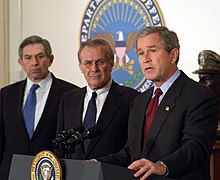 George W. Bush
George W. Bush announces his $74.7 billion wartime supplemental budget request as
Donald Rumsfeld and
Paul Wolfowitz look on.
Government officials
[edit] Bill Kristol
Bill Kristol orating at
Arizona State University in March 2017
- John P. Walters – former U.S. government official, current President and Chief Executive Officer of Hudson Institute[147]
- Nadia Schadlow – academic and defense-related government officer[148]
- Elliot Abrams – foreign policy advisor[149][150][151][152][153]
- Richard Perle – former Assistant Secretary of Defense and lobbyist[149][153]
- John R. Bolton[154]
- Kenneth Adelman – former Director of Arms Control and Disarmament Agency[153]
- William Bennett – former chairman of the National Endowment for the Humanities, former Director of the National Drug Control Policy and former U.S. Secretary of Education[149][155]
- Eliot A. Cohen – former State Department Counselor, now Robert E. Osgood Professor of Strategic Studies at the Paul H. Nitze School of Advanced International Studies at the Johns Hopkins University[156][157]
- Eric S. Edelman – former Under Secretary of Defense for Policy[158]
- Evelyn Farkas – Executive Director of the McCain Institute, former Deputy Assistant Secretary of Defense for Russia, Ukraine and Eurasia[159]
- Douglas J. Feith – former Under Secretary of Defense for Policy[152]
- Jeane Kirkpatrick – former Ambassador to the United Nations under Ronald Reagan, influenced by traditional realist thinking[160]
- David J. Kramer – Executive Director of the George W. Bush Institute, former Assistant Secretary of State for Democracy, Human Rights and Labor[161]
- Bill Kristol – former Chief of Staff to the Vice President of the United States, co-founder and former editor of The Weekly Standard, professor of political philosophy and American politics and political adviser[162][163]
- Scooter Libby – former Chief of Staff to the Vice President of the United States[164][152]
- Victoria Nuland – former Under Secretary of State for Political Affairs[165]
- Condoleezza Rice[131]
- Randy Scheunemann – foreign policy advisor and lobbyist[166]
- Kurt Volker – former U.S. Permanent Representative to NATO[167]
- Paul Wolfowitz – former State and Defense Department official[149][168][169][152]
- R. James Woolsey Jr. – former Undersecretary of the Navy, former Director of Central Intelligence, green energy lobbyist[170][152][157][153][171]
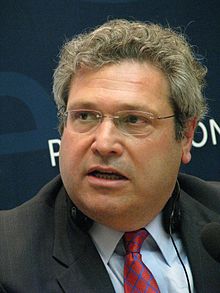 Robert Kagan
Robert Kagan  David Frum
David Frum speaking to Policy Exchange in 2013
 Lulu Schwartz
Lulu Schwartz- Lulu Schwartz - American journalist, author and columnist who held a senior policy analyst role at Foundation for Defense of Democracies (FDD), a neo-conservative think tank based in Washington, D.C.[177][178]
- Niall Ferguson[179]
- David Frum – journalist, Republican speechwriter and columnist[180][181][182]
- Reuel Marc Gerecht – writer, political analyst and senior fellow at the Foundation for Defense of Democracies[183]
- Jonah Goldberg – founding editor of The Dispatch
- David Horowitz
- Bruce P. Jackson – activist, former U.S. military intelligence officer[153]
- Donald Kagan – Sterling Professor of Classics and History at Yale University †.[184][185]
- Frederick Kagan – historian, resident scholar at the American Enterprise Institute[186][187][188]
- Robert Kagan – senior fellow at the Brookings Institution, scholar of U.S. foreign policy, founder of the Yale Political Monthly, adviser to Republican political campaigns and one of 25 members of an advisory board to Hillary Clinton at the State Department (Kagan calls himself a "liberal interventionist" rather than "neoconservative")[189][190]
- Charles Krauthammer – Pulitzer Prize winner, columnist and psychiatrist † [191]
- Irving Kristol – publisher, journalist and columnist † [192]
- Eli Lake – journalist and columnist[193]
- Michael Ledeen – historian, foreign policy analyst, scholar at the American Enterprise Institute[153]
- Clifford May – founder and president of the Foundation for Defense of Democracies[194]
- Joshua Muravchik - political scholar[195]
- Douglas Murray[196]
- Michael Pillsbury[197]
- Daniel Pipes[198]
- Richard Pipes[199]
- Danielle Pletka – American Enterprise Institute vice president[200]
- John Podhoretz – editor of Commentary[201]
- Norman Podhoretz – editor-in-chief of Commentary[202][203]
- Yuval Levin – founding editor of National Affairs (2009–present) and director of Social, Cultural, and Constitutional Studies at the American Enterprise Institute.[204]
- Michael Rubin – resident scholar at the American Enterprise Institute[205]
- Gary Schmitt – resident scholar at the American Enterprise Institute[206][207]
 Ben Shapiro
Ben Shapiro speaking at the 2016
Politicon at the
Pasadena Convention Center in
Pasadena,
CaliforniaDefunct publications
[edit].mw-parser-output .portalbox{padding:0;margin:0.5em 0;display:table;box-sizing:border-box;max-width:175px;list-style:none}.mw-parser-output .portalborder{border:1px solid var(--border-color-base,#a2a9b1);padding:0.1em;background:var(--background-color-neutral-subtle,#f8f9fa)}.mw-parser-output .portalbox-entry{display:table-row;font-size:85%;line-height:110%;height:1.9em;font-style:italic;font-weight:bold}.mw-parser-output .portalbox-image{display:table-cell;padding:0.2em;vertical-align:middle;text-align:center}.mw-parser-output .portalbox-link{display:table-cell;padding:0.2em 0.2em 0.2em 0.3em;vertical-align:middle}@media(min-width:720px){.mw-parser-output .portalleft{margin:0.5em 1em 0.5em 0}.mw-parser-output .portalright{clear:right;float:right;margin:0.5em 0 0.5em 1em}}
To: BroJoeK; PIF
Thank you for talking to me. Expect a reprimand from Mother PIF.
While I was looking at cheerleaders in HS, it isn't surprising that you argued foreign policy with classmates in the early 1960s. Yours is the nature of Neocons. One thing that can't be argued is the steep decline America has been in since the Kennedy assassination, largely do to American interventionism as it relates to foreign policy. Every military engagement you list, post WWII has been both undeclared and a battlefield calamity. On at least 125 occasions a US president has employed military forces without authorization from Congress. One of the most significant of these occasions was the Korean War, where the United States led a peacekeeping United Nations force to stop North Korea's invasion against South Korea.
" data-cf-modified-92d7ea57643abefe833de912-="">Pin3
US President Donald Trump recently ordered a Tomahawk missile strike against the Assad regime in Syria without first seeking Congressional authorization. This has generated controversy regarding the legal powers of the presidency.
According to the US Constitution, the president can only use military force offensively once Congress has declared war on an adversary. The 1973 War Powers Act provided a more flexible alternative, stating that the president could order the military to engage in offensive action for a period of 60 days. After that, the president would have to ask Congress for an Authorization for Use of Military Force.
However, history is full of examples where the president, for various reasons, was able to go to war without any approval from Congress at all.
10 Operation Uphold Democracy
Haiti, 1994–95
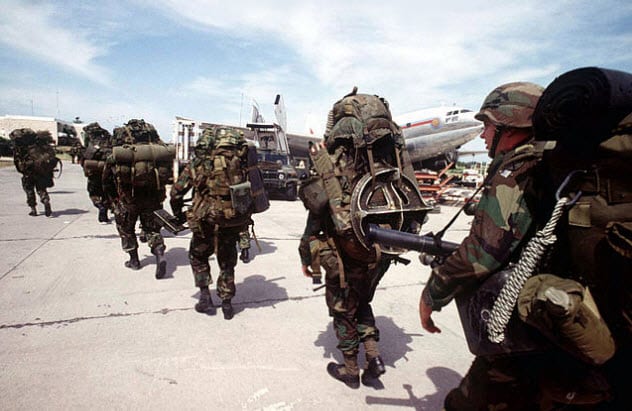
The democratically elected president of Haiti, Jean-Bertrand Aristide, was exiled following a 1991 military coup. President William Clinton eventually decided to invade Haiti to restore Aristide to power.
Operation Uphold Democracy involved dropping a massive force, including the entire 82nd Airborne Division, into Haiti. Realizing that they did not stand a chance, the coup government immediately surrendered. Aristide triumphantly reentered the country under US protection.
Both the US public and a bipartisan Congressional majority were initially opposed to the intervention. President Clinton nevertheless argued that a UN Security Council resolution, authorizing the removal of the coup government, gave him the right to act without consent from Congress.
Although the operation seemed like a resounding success at the time, democracy was not upheld for long. Aristide proved to be a flawed leader and was accused of using electoral fraud to stay in power. Ultimately, he was overthrown again in a 2004 coup, which he ironically blamed on the United States.[1]
9 American Expeditionary Force Siberia
1918–1920
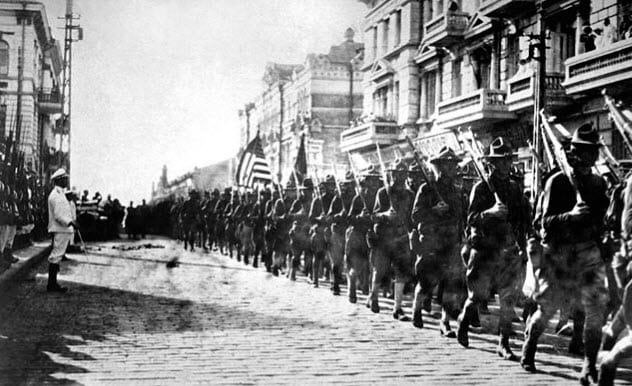
Near the end of World War I, President Woodrow Wilson ordered nearly 8,000 US troops to Siberia as part of a larger Allied intervention. Russia had begun the war on the side of the Allies. However the October Revolution of 1917 resulted in a Bolshevik government, which immediately sued for peace with Germany. The Allies hoped that by helping White Russian counterrevolutionaries remove the Bolsheviks from power, Russia would reenter the war against Germany.
Although the intervention was originally seen as part of World War I, the US troops remained in Siberia even after Germany surrendered in November 1918. In what quickly turned into a quagmire,[2] the US troops fought not only the Bolsheviks but also some of the White Russians they had been sent to help, all while enduring temperatures as low as -46 degrees Celsius (-50 °F). Wilson still wanted to overthrow the Bolshevik government, but public opposition steadily mounted.
The American forces were ultimately withdrawn in 1920, and the Red Army eventually gained control of Siberia. The Allied intervention resulted in lasting hostility between the United States and the Soviet government, which the US did not recognize until 1933.
8 Operation Desert Fox
Iraq, 1998
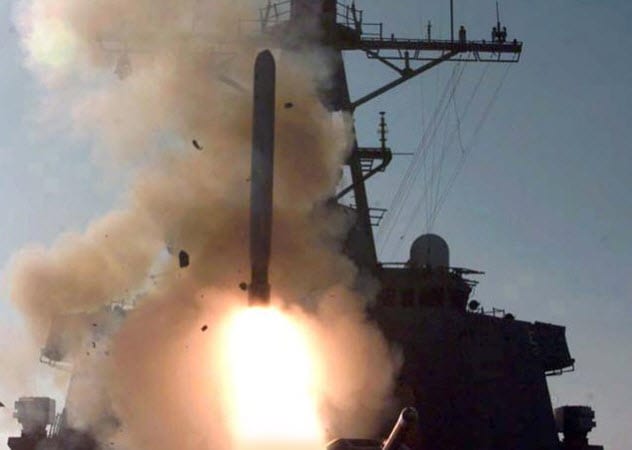
US President William Clinton launched Operation Desert Fox, code name for an intense three-day bombing of Iraq, to degrade Saddam Hussein’s ability to manufacture weapons of mass destruction (WMD). While the bombing substantially damaged Iraq’s military capabilities and infrastructure, it remains unclear if the strikes had any impact on Iraqi WMD development.
Clinton did not seek Congressional authorization before launching the strikes. He argued that the 1998 Iraq Liberation Act provided sufficient legal justification for the campaign. The act stated, “It should be the policy of the United States to support efforts to remove the regime headed by Saddam Hussein from power in Iraq.”[3]
Although the Republican-controlled Congress was inclined to take a hard line against Saddam, the president’s critics noted that the timing of the strikes seemed odd. Desert Fox coincided with the ongoing impeachment debate over Clinton’s perjury during the Monica Lewinsky scandal.
Despite the bombings, Saddam remained in power until Operation Iraqi Freedom in 2003. Meanwhile, the House voted to impeach President Clinton on December 19, 1998, the last day of bombing for Operation Desert Fox.
7 Undeclared War In The Atlantic
1941

Prior to the attack on Pearl Harbor, most Americans were against entering World War II. Nevertheless, from summer 1940 through 1941, Great Britain was fighting for its survival against Nazi Germany. President Franklin Roosevelt knew that war was inevitable and wanted to secretly help Britain as much as possible.
In May 1940, the British invaded Iceland because they were worried that the Germans would try to use it as a base of operations for their aircraft and U-boats. Soon afterward, Roosevelt sent US troops to occupy the island. This kept it safe from Germany, while freeing the British garrison to fight elsewhere. Roosevelt also gave 50 American destroyers to Britain in exchange for long-term leases on British naval bases in Newfoundland and the Caribbean.
The undeclared war intensified in September 1941 when a German submarine torpedoed an American destroyer near Iceland. In retaliation, President Roosevelt ordered US naval vessels and planes to attack any German submarines spotted in “waters we deem necessary for our defense.”[4] This ambiguous statement amounted to a de facto opening of hostilities a full three months before Germany declared war on the US in December 1941.
6 Operation Just Cause
Panama, 1989–1990

Tensions between Manuel Noriega, the military leader of Panama, and the United States deteriorated throughout the 1980s. The US government accused Noriega of helping drug smugglers in exchange for kickbacks. The final straw came in December 1989 when Noriega’s paramilitary forces guarding a checkpoint fired upon a group of US naval officers stationed in the Panama Canal Zone, killing one.
In retaliation, President George H.W. Bush ordered an invasion of Panama, which quickly neutralized Noriega’s military. Cut off from all avenues of escape, Noriega fled to the Vatican Embassy in Panama City. US troops responded by blasting heavy rock into the embassy, and Noriega surrendered two weeks later.
The intervention was extremely popular both within Congress and among the general public. Since Operation Just Cause was concluded in only 42 days, President Bush beat out the 60-day clock established by the War Powers Act and never had to seek formal Congressional authorization.[5]
5 NATO Intervention In Libya
2011
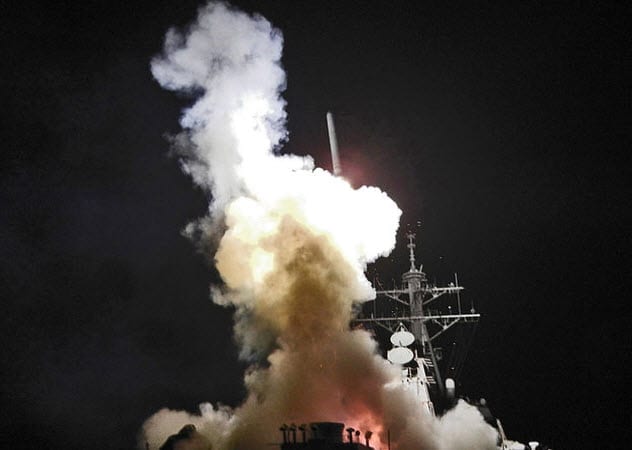
The Libyan Civil War started in February 2011 after dictator Muammar Gadhafi’s security forces began executing Arab Spring protesters who called for his resignation. Although the rebels quickly seized the city of Benghazi, Gadhafi’s troops soon appeared poised to retake the city and unleash a retaliatory bloodbath.
Citing a UN Security Council resolution to protect civilians and impose a no-fly zone, NATO forces began a concerted air campaign against Gadhafi. This quickly turned the tide of war in favor of the rebels.
President Barack Obama did not seek Congressional authorization before launching air strikes. He argued that the War Powers Act did not apply because the US military was intervening in support of NATO rather than fighting alone. Congress did not accept this explanation but had no way of forcing Obama to withdraw.
Ultimately, the air campaign ended in October 2011 after Gadhafi was caught hiding in a drainpipe and was killed under mysterious circumstances. The Libyan intervention is extremely controversial today, partly because of the 2012 assassination of the US ambassador in Benghazi.[6]
4 Kosovo War
1999

The Kosovo War began as an insurgency by Kosovo Liberation Army paramilitaries who sought independence from the Serbian-dominated Federal Republic of Yugoslavia. In retaliation, the Yugoslav Army responded with a heavy-handed attempt to stamp out the insurgency, massacring civilians and creating a refugee crisis. NATO began a bombing campaign to evict the Yugoslav Army from Kosovo after international attempts to broker a political settlement failed.
Interestingly, President Clinton requested an authorization for the use of military force in Kosovo, which was passed by the Senate. However, the same authorization failed to pass the House after a rare 213–213 tie.[7]
Clinton continued bombing the Yugoslav Army anyway. He argued that Congress had appropriated funding for the intervention, which was basically the same as authorizing it. The Yugoslav Army was forced to withdraw from Kosovo, which eventually gained its independence.
3 Punitive Expedition Against Pancho Villa
Mexico, 1916–17

In 1916, the Mexican warlord Pancho Villa launched a raid against the border town of Columbus, New Mexico. It was in retaliation for US support for Venustiano Carranza, Villa’s rival in the ongoing Mexican Revolution.
Although Villa’s forces were repulsed from Columbus with heavy losses, the US public was outraged. President Woodrow Wilson ordered General John J. Pershing and a division of US troops to pursue Villa into Mexico to kill or capture him.[8]
The expedition was justified from a legal standpoint as a defensive action due to Villa’s raid on Columbus. Thus, no declaration of war was required. However, as the term “punitive expedition” would suggest, the intervention was aimed not only at securing US borders but also at retaliation.
The expedition marched over 800 kilometers (500 mi) into Mexico and inflicted severe losses on Villa’s forces. However, US forces were ultimately forced to withdraw due to Carranza’s objections that Mexican sovereignty was being violated. This allowed Villa to escape.
2 Operation Urgent Fury
Grenada, 1983
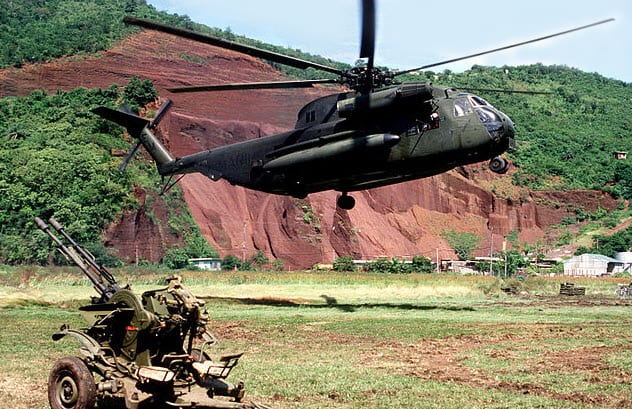
President Ronald Reagan initiated Operation Urgent Fury in October 1983 as a result of ongoing instability in the Marxist-controlled island of Grenada. The prime minister of Grenada had recently been executed in a violent coup, and the new government imposed a strict 24-hour curfew enforced by summary execution. Fearing that US medical students on the island would be harmed, Reagan ordered an invasion.
An air assault quickly captured the only two airports on the island despite heavy resistance from the Grenadians and their Cuban military advisers.[9] Major combat operations concluded within three days, the Grenadian government was replaced, and all US students were rescued safely.
When asked why he did not seek Congressional authorization, President Reagan argued that he had to act decisively to save the lives of the medical students. In any event, the speed of the invasion meant that Congress was presented with a fait accompli. The intervention was condemned internationally as a violation of Grenada’s sovereignty but was extremely popular at home. It even inspired a Clint Eastwood movie.
1 The Korean War
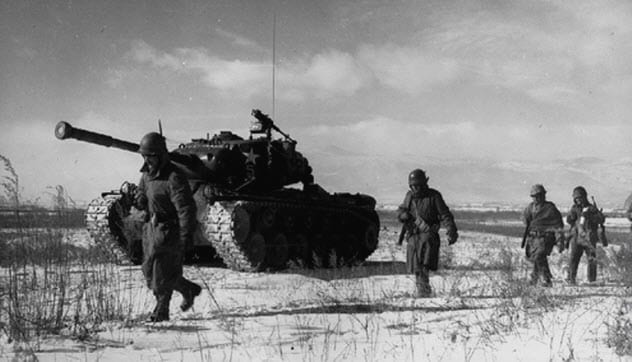
In June 1950, North Korean leader Kim Il Sung ordered a massive invasion of South Korea. This caught both the South Koreans and the United States completely by surprise. President Harry Truman was initially reluctant to send US troops to Korea, fearing that this would lead the Soviets and Chinese to also intervene.
Then, in one of the greatest diplomatic blunders in history, the Soviets boycotted a UN Security Council meeting to protest that Mao’s Communist government had not been given China’s Security Council seat despite winning the Chinese Civil War. The Security Council passed a resolution asking UN member states to assist South Korea. The Soviets were unable to veto it due to their absence.[10]
President Truman used the UN resolution as a justification for US intervention and drove back the North Koreans. Although the Korean War dragged on for three more years in a lengthy stalemate, Truman never requested a declaration of war from Congress. He argued that the war was legally covered by the UN resolution.
Henry is a graduate of the Johns Hopkins University. He currently lives and works in Washington, DC.
To: PIF
True, will never know
Just like 15k killed in Afghanistan. Seems unlikely it was that low
Navigation: use the links below to view more comments.
first previous 1-20 ... 11,001-11,020, 11,021-11,040, 11,041-11,060 ... 22,221-22,233 next last
Disclaimer:
Opinions posted on Free Republic are those of the individual
posters and do not necessarily represent the opinion of Free Republic or its
management. All materials posted herein are protected by copyright law and the
exemption for fair use of copyrighted works.
FreeRepublic.com is powered by software copyright 2000-2008 John Robinson
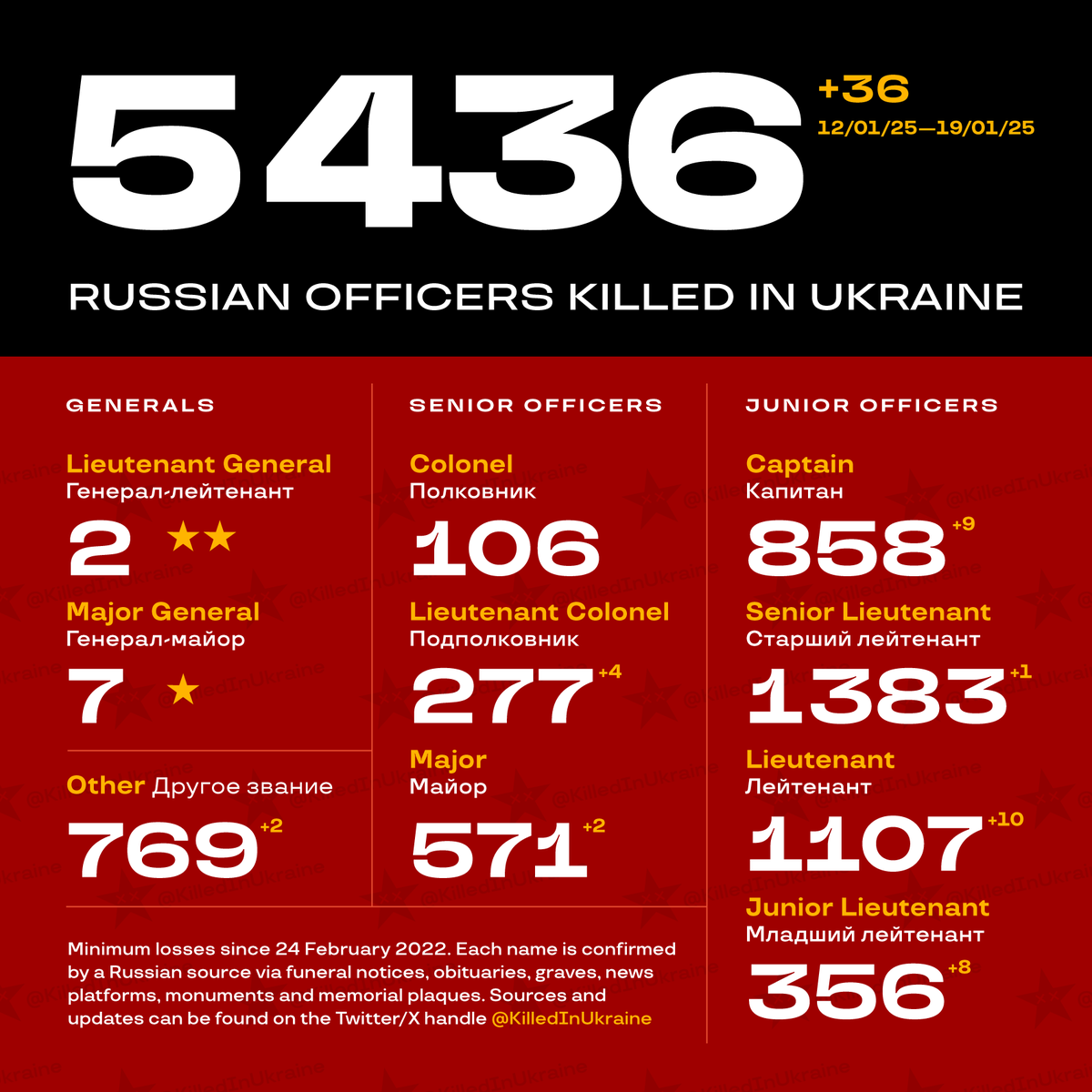
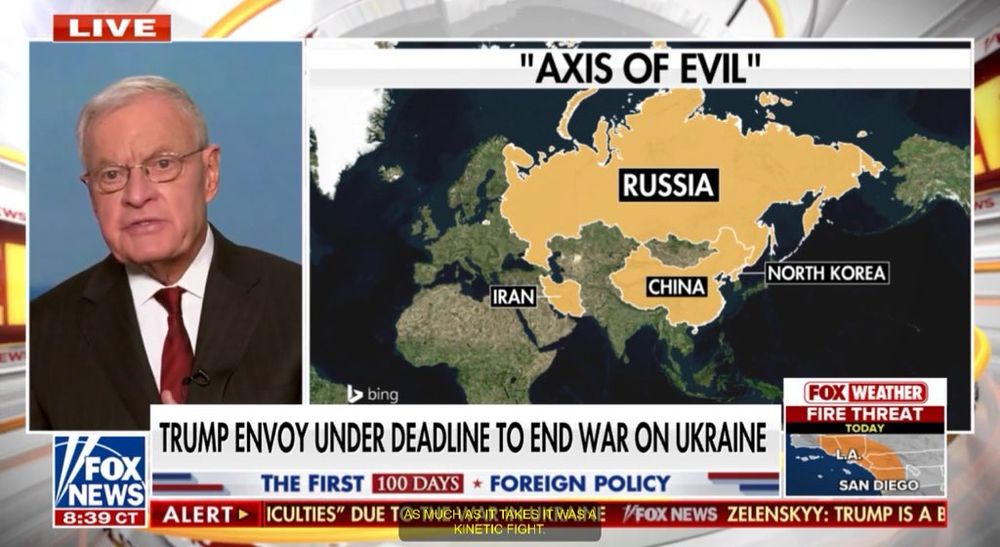

 In 1962 I was a boy, a student at Monterey High School (California), and sometimes discussed international relations with a kid my age who debated like JonPreston -- forever bringing up "facts" to prove that the US was always wrong, and the Russians or Chi-Coms were always right.
In 1962 I was a boy, a student at Monterey High School (California), and sometimes discussed international relations with a kid my age who debated like JonPreston -- forever bringing up "facts" to prove that the US was always wrong, and the Russians or Chi-Coms were always right. Finally, it would be an interesting question to discuss, whether the CIA learned its coup tradecraft from the KGB, or was it the other way around?
Finally, it would be an interesting question to discuss, whether the CIA learned its coup tradecraft from the KGB, or was it the other way around?















